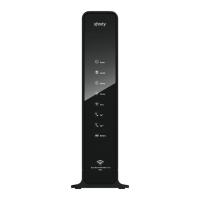1 Choose an appropriate and safe location to install the Residential Gateway (close
to a power source, an active cable connection, your PC-if using high-speed
Internet, and your telephone lines-if using VoIP). For assistance, refer to Where Is
the Best Location for My Residential Gateway? (on page 16).
WARNING:
To prevent possible damage to equipment, disconnect any other telephone
service before connecting your Residential Gateway to the same wires.
Hazardous electrical voltages can exist on the telephone, Ethernet, or coax
cable wiring. Be sure to disconnect AC power from all devices while
installing your service.
All wiring and connections must be properly insulated to prevent
electrical shock.
Telephone connections to an installed home telephone wiring network
should be done by a qualified installer. The cable telephone service
provider may offer professional installation and connection to the home
telephone wiring network. A fee may be charged for this service.
2 Power off your PC and other networking device; then, unplug them from the
power source.
3 Connect the active RF coaxial cable from your service provider to the coax
connector labeled MoCA/CABLE on the back of the Residential Gateway.
Note: To connect a TV, DHCT, set-top, or VCR from the same cable connection,
you will need to install a cable signal splitter (not included). Always check with
your service provider before using a splitter as a splitter may degrade the signal.
For more information about a MoCA installation, see MoCA Installation
Guidelines (on page 22).
4 Connect your PC to the Residential Gateway using one of the following methods:
Ethernet Connection. Connect one end of an Ethernet cable to the Ethernet
port on your PC, and connect the other end to the Ethernet port on the back
of the Residential Gateway.
Wireless Connection. Make sure that your wireless device is powered up.
You will need to associate your wireless device with the Residential Gateway
once the Residential Gateway is operational. Follow the directions provided
with your wireless device for associating with a wireless access point. Make
sure that either the 2.4 GHz or the 5 GHz indicator is ON.
For more information about the factory default configuration of the
DPC3941T, see Configure Wireless Settings (on page 26).
5 If your Residential Gateway supports digital telephone service (VoIP), connect
one end of a telephone jumper cable (not included) to a telephone outlet in your
home or to a telephone or fax machine. Then connect the other end of the jumper
cable to the appropriate RJ-11 Tel1 or Alarm/Tel2 port on the back of the
Residential Gateway.
Notes: Telephones that require electrical connectors other than RJ-11 may require
an external adapter (sold separately).

